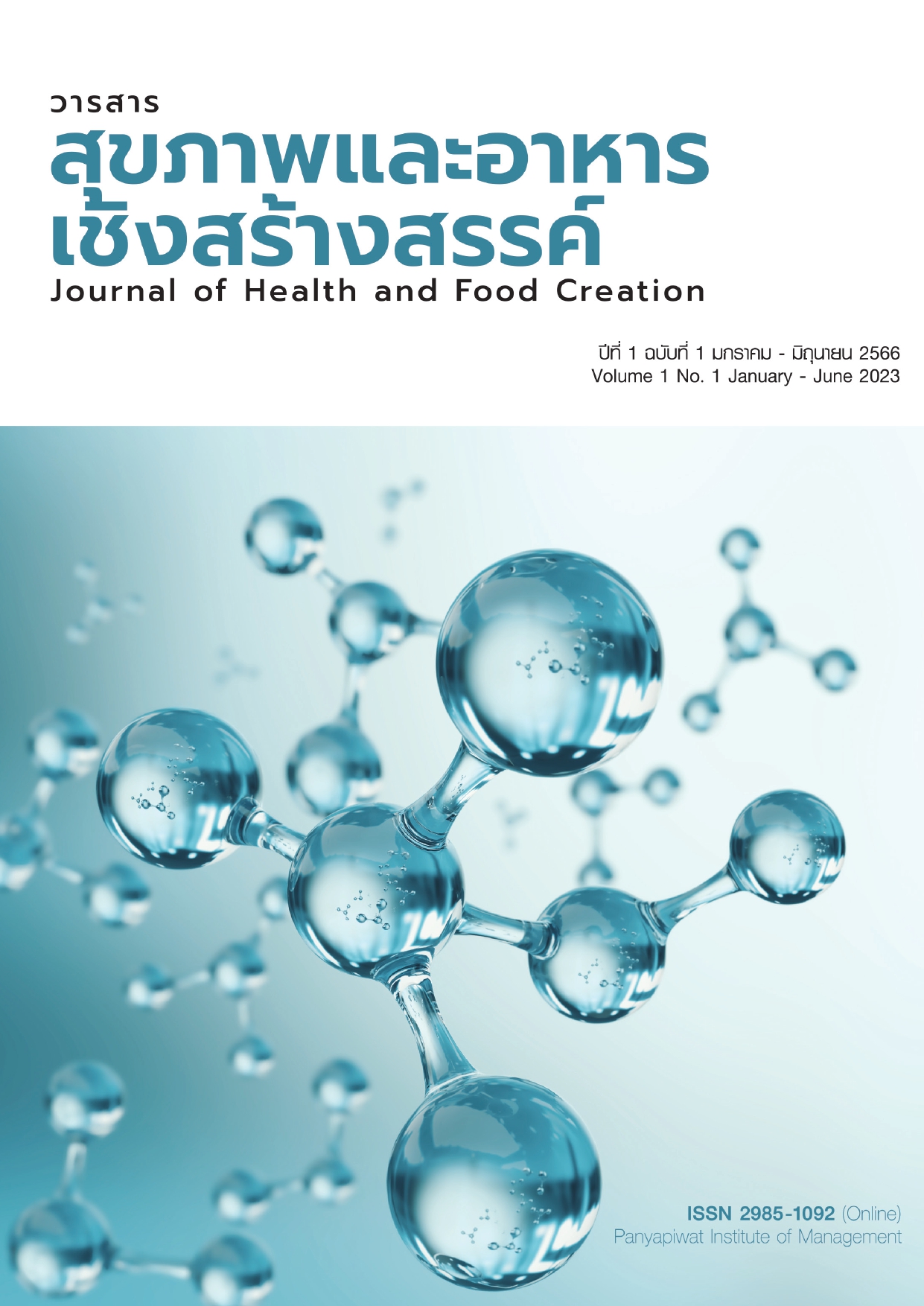DIGITAL TECHNOLOGY APPLICATION FOR CANCER PATIENTS RECEIVING CHEMOTHERAPY
Keywords:
Digital Technology, Cancer Patients, ChemotherapyAbstract
Cancer is a major morbidity and mortality problem in Thailand causing patients to lose their good quality of life, to suffer from symptoms of illness, treatment and travel expenses, and loss of income for patients and their families, with the impacts on the economy and society. The main treatment for cancer is chemotherapy. The patients who have received chemotherapy may experience side effects of chemotherapy such as bone marrow suppression, neutropenia, hair loss, Chemotherapy-Induced Peripheral Neuropathy (CIPN), fatigue, muscle pain, and anorexia. The important things in giving care to patients are the monitoring of the patients’ symptoms on a regular basis, and the management of side effects that may occur in order to promote the quality of physical and mental health of the patients. Digital technology has become an essential component of human life and applied in the health industry such as mobile health, telemedicine and tele-nursing for patient monitoring. The use of digital technology in cancer chemotherapy care has not only improved the efficacy of cancer treatment but also facilitated the continuous monitoring of side effects after chemotherapy administration. It has also reduced hospital overcrowding, the risk of COVID-19 transmission, and the number of hospital visits, resulting in significant cost savings.
References
Chaitosa, R., & Sumdaengrit, B. (2016). Symptom severity in gynecological oncology patients receiving paclitaxel and carboplatin. Journal of Nursing and Health Care, 34(2), 49-57. [in Thai]
Cheevakasemsook, A. (2021). Digital technology for patient care: An essential for cardio-thoracic nurses in the 21st century. Thai Journal of Cardio-Thoracic Nursing, 32(1), 2-13. [in Thai]
França, A. C., Rodrigues, A. B., Aguiar, M. I. F. D., Silva, R. A., Freitas, F. M. C., & Melo, G. A. A. (2019). Telenursing for the control of chemotherapy-induced nausea and vomiting: A randomized clinical trial. Texto & Contexto-Enfermagem, 28, 1-15.
Kitreerawutiwong, K., Kitreerawutiwong, N., & Wongsawang, N. (2017). Public health in the era of Thailand 4.0. Journal of Health Science, 26(2), 377-388. [in Thai]
Ministry of Public Health. (2021). Digital health strategy, Ministry of Public Health (2021-2025). https://ict.moph.go.th/upload_file/files/97c2287c8f04e13f81fec13e431e7a5e.pdf [in Thai]
National Cancer Institute. (2018). National cancer control programme (2018-2022). https://www.nci.go.th/th/New_web/officer/of3.html [in Thai]
National Cancer Institute. (2021). Hospital-based cancer registry 2020. https://www.nci.go.th/e_book/hosbased_2563/files/main.pdf [in Thai]
Promnimit, A., Pakdevong, N., & Binhosen, V. (2022). Feasibility study of symptoms management application for colorectal cancer patient undergoing chemotherapy. The Journal of Faculty of Nursing Burapha University, 3(2), 40-52. [in Thai]
Saedkong, P., Potchana, R., Wayo, W., & Klungklang, R. (2020). Effects of using Hug Tai application on health literacy among patients with diabetes type 2, hypertension, and chronic kidney disease stage 3 at Wat Nong Weang Pra-Aramluarg parimary care unit in Khon Kaen. The Southern College Network Journal of Nursing and Public Health, 7(3), 195-206. [in Thai]
Sato, D., & Shimoyama, M. (2022). Effectiveness of a telenursing system on side effects of chemotherapy by a crossover trial. Open Journal of Nursing, 12(12), 817-830.
Singnoi, W., & Supraser, P. (2017). Bone marrow toxicity from chemotherapy. https://w1.med.cmu.ac.th/obgyn/lecturestopics/topic-review/5446/ [in Thai]
Sirimongkollertkul, N., Singmanee, C., Rattanawichai, T., & Pongleerat, S. (2020). Development of Diabetic monitoring mobile application. Royal Thai Army Medical Journal, 73(3), 141-150. [in Thai]
Sullivan, C. W., Leutwyler, H., Dunn, L. B., & Miaskowski, C. (2018). A review of the literature on symptom clusters in studies that included oncology patients receiving primary or adjuvant chemotherapy. Journal of Clinical Nursing, 27(3-4), 516-545.
Thailand Nursing and Midwifery Council. (2022). Tele-nursing. https://www.tnmc.or.th/images/userfiles/files/T_0049.PDF [in Thai]
Thongtang, N. (2019). Non-communicable disease (NCDs). https://www.si.mahidol.ac.th/th/healthdetail.asp?aid=1371 [in Thai]
Tupcharoen, P., & Pakdevong, N. (2022). Development and feasibility study of self management application for head and neck cancer patients undergoing radiotherapy or concurrent chemoradiotherapy. APHEIT Journal of Nursing and Health, 4(1), 1-20. [in Thai]
Wangwatcharakul, W., Kapol, N., & Bunchuailua, W. (2018). The effectiveness of telemedicine for breast cancer disease management: A systematic review and meta-analysis. Thai Bulletin of Pharmaceutical Sciences, 13(2), 145-161. [in Thai]
Warrington, L., Absolom, K., Conner, M., Kellar, I., Clayton, B., Ayres, M., & Velikova, G. (2019). Electronic systems for patients to report and manage side effects of cancer treatment: Systematic review. Journal of Medical Internet Research, 21(1), e10875.
Wattanathum, K., Dhippayom, T., & Fuangchan, A. (2021). Types of activities and outcomes of telepharmacy: A review article. Isan Journal of Pharmaceutical Sciences, 17(3), 1-15. [in Thai]
WHO Global Observatory for eHealth. (2010). Telemedicine: Opportunities and developments in member states: Report on the second global survey on eHealth. https://apps.who.int/iris/handle/10665/44497
World Health Organization (WHO). (2020). Cancer statistics. https://www.who.int/news-room/fact-sheets/detail/cancer
Downloads
Published
Issue
Section
License
Copyright (c) 2023 Journal of Health and Food Creation

This work is licensed under a Creative Commons Attribution-NonCommercial-NoDerivatives 4.0 International License.
“ข้าพเจ้าและผู้เขียนร่วม (ถ้ามี) ขอรับรองว่า บทความที่เสนอมานี้ยังไม่เคยได้รับการตีพิมพ์และไม่ได้อยู่ระหว่างกระบวนการพิจารณาลงตีพิมพ์ในวารสารหรือแหล่งเผยแพร่อื่นใด ข้าพเจ้าและผู้เขียนร่วมยอมรับหลักเกณฑ์การพิจารณาต้นฉบับ ทั้งยินยอมให้กองบรรณาธิการมีสิทธิ์พิจารณาและตรวจแก้ต้นฉบับได้ตามที่เห็นสมควร พร้อมนี้ขอมอบลิขสิทธิ์บทความที่ได้รับการตีพิมพ์ให้แก่สถาบันการจัดการปัญญาภิวัฒน์หากมีการฟ้องร้องเรื่องการละเมิดลิขสิทธิ์เกี่ยวกับภาพ กราฟ ข้อความส่วนใดส่วนหนึ่งและ/หรือข้อคิดเห็นที่ปรากฏในบทความข้าพเจ้าและผู้เขียนร่วมยินยอมรับผิดชอบแต่เพียงฝ่ายเดียว”





